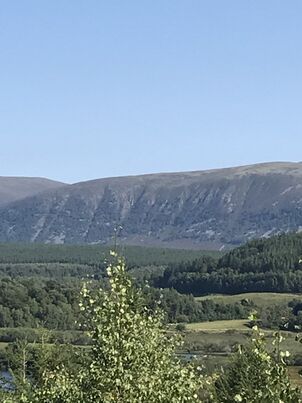
Believe it or not there are ponies in this photo. A group of ponies in a landscape, a landscape of forest, shrubs, open water, marsh, and meadow. Ponies as humans might have known them before domestication began around 6000 years ago.
From time to time on my horsey path something comes along which changes the course of my path for ever. These ponies did that. (Can you spot them?)
From time to time on my horsey path something comes along which changes the course of my path for ever. These ponies did that. (Can you spot them?)
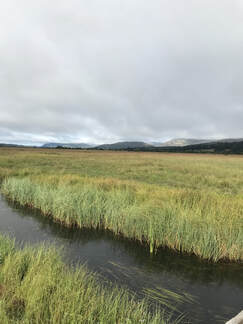
'Come and spend 8 days immersed in the wild lives of semi feral horses and ponies. We will be situated in the spectacular land and seascape of the Cairngorms National Park and the Outer Hebrides.
The guides are professional trainers, teachers and researchers in the field of horse-human interactions. This is a chance to explore, expand, and enrich our understanding of horses and the horse-human relationship.'
What an irresistible invitation! You have to love Facebook for the gems that pop up! Sadly the full 8 days was logistically impossible, however the first 4, based at the Highland Wildlife Park near Kingussie in Scotland's Cairngorms National Park and learning about the ponies which graze the Royal Society for the Protection of Birds (RSPB) reserve at Insh Marshes was all on. So off I went for a few days which are now filed in the store of precious memories which I hope I will keep to return to long after I can't remember what happened 5 minutes ago.
The course was the brainchild of Bonny Mealand (https://touching-wild.blog/). A glance at Bonny's blog reveals her complete commitment to learning about and understanding the horse, and her enormous depth of knowledge and experience in finding ways of working which respect and blend with the innate characteristics of an animal which so often is misunderstood and imposed upon. Bonny is a remarkable lady and it was a privilege to meet and study with her.
The other two facilitators on the course were from Sweden and the United States. They brought their immense expertise in education and the science of studying how horses and humans interact, plus an international perspective which added breadth and depth to lively discussions which did not shy away from addressing difficult questions.
However this was so much more than just a group of horsey folk talking about horses. We were at Insh Marshes because the ponies here live with a minimum of human intervention, and one aspect of our study was to look at how they spend their lives, and to discuss the development of low stress handling techniques which will mean that their welfare can be maintained, but there were also participants whose primary focus was on the ponies' role in grazing the reserve to maintain and improve its fragile habitats. This combination led to fascinating, far reaching, at times deeply depressing but also inspiring talks about horse keeping, horse training, human psychology, conservation, rewilding, and the impact of humans on the planet. My mental filing cabinet rediscovered the drawer which contains 25 years of voluntary work in wildlife conservation - adding another dimension to a truly fabulous time.
The guides are professional trainers, teachers and researchers in the field of horse-human interactions. This is a chance to explore, expand, and enrich our understanding of horses and the horse-human relationship.'
What an irresistible invitation! You have to love Facebook for the gems that pop up! Sadly the full 8 days was logistically impossible, however the first 4, based at the Highland Wildlife Park near Kingussie in Scotland's Cairngorms National Park and learning about the ponies which graze the Royal Society for the Protection of Birds (RSPB) reserve at Insh Marshes was all on. So off I went for a few days which are now filed in the store of precious memories which I hope I will keep to return to long after I can't remember what happened 5 minutes ago.
The course was the brainchild of Bonny Mealand (https://touching-wild.blog/). A glance at Bonny's blog reveals her complete commitment to learning about and understanding the horse, and her enormous depth of knowledge and experience in finding ways of working which respect and blend with the innate characteristics of an animal which so often is misunderstood and imposed upon. Bonny is a remarkable lady and it was a privilege to meet and study with her.
The other two facilitators on the course were from Sweden and the United States. They brought their immense expertise in education and the science of studying how horses and humans interact, plus an international perspective which added breadth and depth to lively discussions which did not shy away from addressing difficult questions.
However this was so much more than just a group of horsey folk talking about horses. We were at Insh Marshes because the ponies here live with a minimum of human intervention, and one aspect of our study was to look at how they spend their lives, and to discuss the development of low stress handling techniques which will mean that their welfare can be maintained, but there were also participants whose primary focus was on the ponies' role in grazing the reserve to maintain and improve its fragile habitats. This combination led to fascinating, far reaching, at times deeply depressing but also inspiring talks about horse keeping, horse training, human psychology, conservation, rewilding, and the impact of humans on the planet. My mental filing cabinet rediscovered the drawer which contains 25 years of voluntary work in wildlife conservation - adding another dimension to a truly fabulous time.
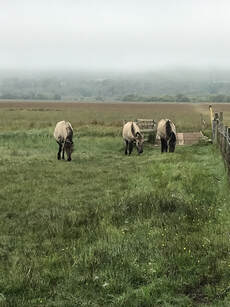
So what is a horse? How do they live their lives when no-one interrupts them? And how do we fit into the picture?
Let's be honest, how many of us, who claim to have the horse's best interests at heart, have actually thought to ask these questions? We may think we know them, but, with a small number of exceptions, the horses we know are defined and constrained by the parameters we impose and the traditions and beliefs of thousands of years of interactions which are predominantly based around our needs, and how the horse can help us meet them. For around 600 million people (https://www.thebrooke.org/) - and I think we in the recreational horse world easily forget this - horses remain crucial to everyday life. They are inextricably bound to the history of humanity.
Let's be honest, how many of us, who claim to have the horse's best interests at heart, have actually thought to ask these questions? We may think we know them, but, with a small number of exceptions, the horses we know are defined and constrained by the parameters we impose and the traditions and beliefs of thousands of years of interactions which are predominantly based around our needs, and how the horse can help us meet them. For around 600 million people (https://www.thebrooke.org/) - and I think we in the recreational horse world easily forget this - horses remain crucial to everyday life. They are inextricably bound to the history of humanity.
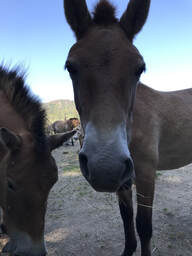
Since there are no truly wild horses (Equus ferus/Equus caballus) left in the world it is impossible for us to study a definitive 'horse', in the same way as we can study elephants or dormice. The nearest we have is the Mongolian Takhi, also known as Przewalski's horse (more about them another time), but even they, having been resurrected from extinction in the wild, have been subject to human influence and so cannot be called truly wild. However we do have a huge number of semi-wild, feral or semi-feral herds throughout the globe, and we have dedicated ethologists such as Lucy Rees patiently gathering knowledge and making it freely available in the hope that the husbandry of horses can be steered towards balancing their needs and our own.
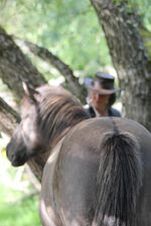
The ponies at Insh Marshes are Polish Koniks (and yes, we did discuss why an imported breed had been chosen over one of our own natives - briefly, I think the answer is partly to do with the fact that all our native breeds originate from upland or heathland habitats, whereas the Konik is specifically suited to wetlands). There are 13 altogether, currently divided into a group of 10 (3 females and 7 geldings) and a group of 3 geldings. Any misconceptions we might have had about geldings lacking a sexual drive were cleared up when we learned about the way in which the original group of 1 female and 7 geldings appropriated the other 2 females when they were introduced, and banished the 3 geldings (more about them later too).
In such a vast landscape finding the ponies from ground level was the first challenge, however we were fortunate on the first day to come across them loafing in the shade of a clump of trees. Needless to say they spotted us long before we saw them, and as we approached the second misconception - that horses are naturally nervous and always ready to flee - went the way of the first. These animals were calmly curious, and because our approach, carefully curated by Bonny, was non threatening, they remained quietly curious until eventually we were among them, sharing their space and their afternoon. An experience I will treasure for ever.
How much noise and bustle we bring into horses' lives! How busy we are around them! Imagine any wildlife documentary footage of chimpanzees on the rampage through the forest - that's us in our everyday lives. Contrast that thought with the image above. That's horses in their everyday lives. Quiet. Calm. Curious. Friendly. Moments of movement when something or someone needed sorted out, over in seconds. Of course, depending on circumstances, things could have got very busy very quickly indeed, and no-one was in the least complacent, however we were all (ponies and people) Aware, not Afraid. I was part of a special group of humans who knew how to be quiet, how to be still, in a very centered and mindful way which created a tangible resonance between our two species.
So what did I see which will cause me to change how I am around horses? I saw, first and foremost, that left to themselves horses are predominantly very calm animals. Of course, the structure of the RSPB group is artificial, which meant that many behaviours were absent, however that did not detract from being able to get a feeling for just how horses are. I saw that they are calm - think how busy and stressed we can be around them; their lives are quiet - think how much we talk to them, fuss over them, talk to other people, shout across the yard, drop things, have the radio on, talk on the phone, how much NOISE we create in their lives; they love to be in each others' company, but companionship, for them, is close without touching - we pat, we stroke, we love to touch our horses because human beings love to touch, handle and hold, but as a result we impose ourselves on them constantly; they are curious and will move towards things to check them out - how much do we take new things to them instead of letting them investigate and work it out for themselves; and I saw that they will move towards a new thing, stretch their neck out and smell it very thoroughly before testing it with lips and teeth, then perhaps touch it with their feet - how often do we pull them away when they take a look and stretch towards something new?
So I will think about consciously slowing down and grounding myself before I approach any horse; I will work on staying calm and emotionally neutral in my mind; I will appreciate that they need to investigate new things, to look and smell; I will take time to be companionable without touching; and I will be quiet.
It's very popular just now to talk about 'connecting' with our horses; words like 'harmony', 'relationship', 'partnership', and 'creating a bond' are scattered throughout articles, social media, blogs and videos. I think this represents a fantastic move away from the 'show him who's boss, don't let him away with it' tradition that so many of us grew up with, however the focus remains, for the most part, towards doing 'stuff' with the horse to create this magical feeling - when, in reality, we are the ones who need to change. The horse is already there, waiting for us to realise that. We need to put the work in on ourselves. We are the ones who need to change. And I think, for many of us, the first things we need to learn are to slow down (if not stop altogether), be quiet, and genuinely get to know the horse. Then, maybe, we can invite him to collaborate with us.
In such a vast landscape finding the ponies from ground level was the first challenge, however we were fortunate on the first day to come across them loafing in the shade of a clump of trees. Needless to say they spotted us long before we saw them, and as we approached the second misconception - that horses are naturally nervous and always ready to flee - went the way of the first. These animals were calmly curious, and because our approach, carefully curated by Bonny, was non threatening, they remained quietly curious until eventually we were among them, sharing their space and their afternoon. An experience I will treasure for ever.
How much noise and bustle we bring into horses' lives! How busy we are around them! Imagine any wildlife documentary footage of chimpanzees on the rampage through the forest - that's us in our everyday lives. Contrast that thought with the image above. That's horses in their everyday lives. Quiet. Calm. Curious. Friendly. Moments of movement when something or someone needed sorted out, over in seconds. Of course, depending on circumstances, things could have got very busy very quickly indeed, and no-one was in the least complacent, however we were all (ponies and people) Aware, not Afraid. I was part of a special group of humans who knew how to be quiet, how to be still, in a very centered and mindful way which created a tangible resonance between our two species.
So what did I see which will cause me to change how I am around horses? I saw, first and foremost, that left to themselves horses are predominantly very calm animals. Of course, the structure of the RSPB group is artificial, which meant that many behaviours were absent, however that did not detract from being able to get a feeling for just how horses are. I saw that they are calm - think how busy and stressed we can be around them; their lives are quiet - think how much we talk to them, fuss over them, talk to other people, shout across the yard, drop things, have the radio on, talk on the phone, how much NOISE we create in their lives; they love to be in each others' company, but companionship, for them, is close without touching - we pat, we stroke, we love to touch our horses because human beings love to touch, handle and hold, but as a result we impose ourselves on them constantly; they are curious and will move towards things to check them out - how much do we take new things to them instead of letting them investigate and work it out for themselves; and I saw that they will move towards a new thing, stretch their neck out and smell it very thoroughly before testing it with lips and teeth, then perhaps touch it with their feet - how often do we pull them away when they take a look and stretch towards something new?
So I will think about consciously slowing down and grounding myself before I approach any horse; I will work on staying calm and emotionally neutral in my mind; I will appreciate that they need to investigate new things, to look and smell; I will take time to be companionable without touching; and I will be quiet.
It's very popular just now to talk about 'connecting' with our horses; words like 'harmony', 'relationship', 'partnership', and 'creating a bond' are scattered throughout articles, social media, blogs and videos. I think this represents a fantastic move away from the 'show him who's boss, don't let him away with it' tradition that so many of us grew up with, however the focus remains, for the most part, towards doing 'stuff' with the horse to create this magical feeling - when, in reality, we are the ones who need to change. The horse is already there, waiting for us to realise that. We need to put the work in on ourselves. We are the ones who need to change. And I think, for many of us, the first things we need to learn are to slow down (if not stop altogether), be quiet, and genuinely get to know the horse. Then, maybe, we can invite him to collaborate with us.
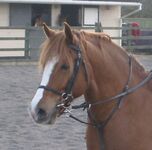

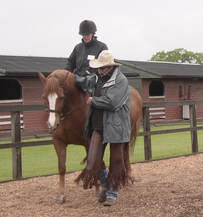
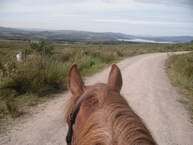
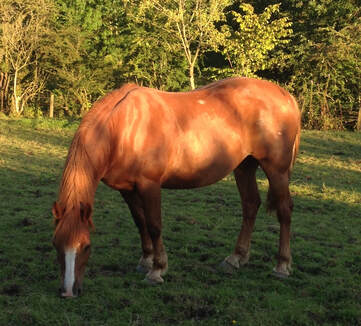
 RSS Feed
RSS Feed